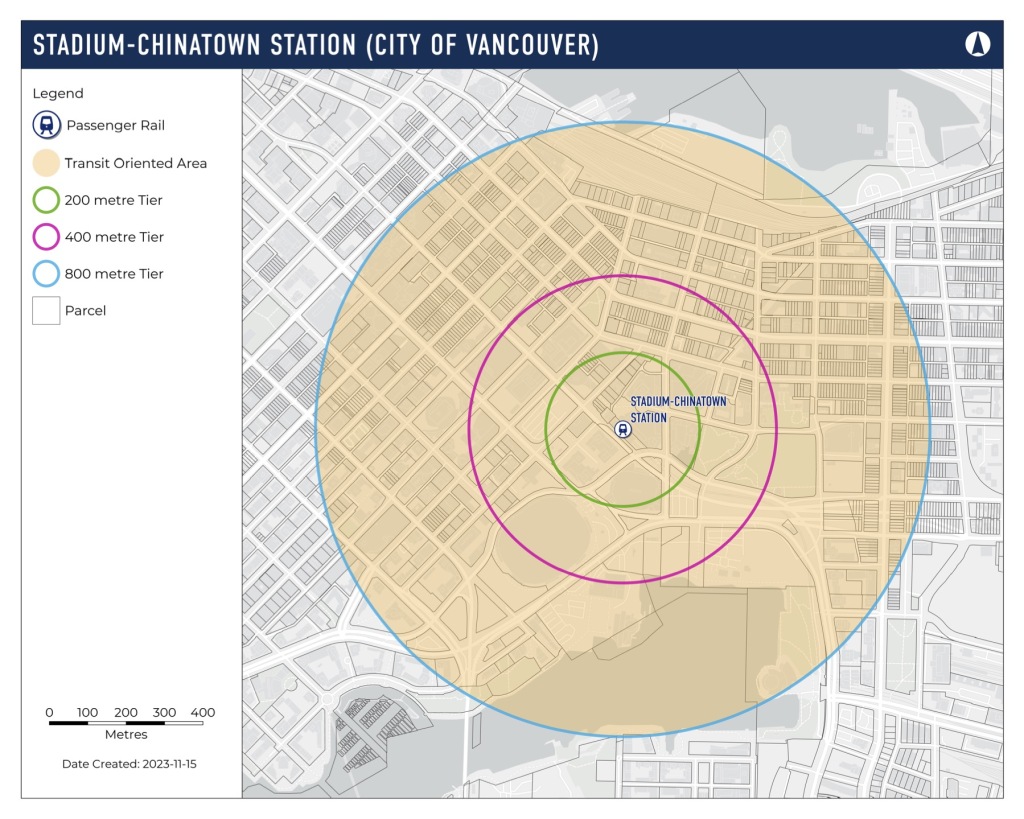Update (April 17, 2024): City Council has added “Response to New Provincial Legislation: Bills 44, 46 and 47” as the first item on the agenda for its April 23rd meeting. As of April 17, 2024, the attached report is available, and citizens can view the agenda and send in their comments here, although speakers are not allowed on this agenda item. The report highlights the lack of clarity from the province regarding the application of Transit-Oriented Areas, including to Chinatown specifically, but does not touch on the recommendations of the Racial and Ethno-Cultural Equity Advisory Committee.
Back in March, the City of Vancouvers’ Racial and Ethno-Cultural Equity Advisory Committee passed a motion recommending Council petition the province for changes to its new Transit-Oriented Areas regime in order to protect Chinatown and introduce affordability benchmarks.
The Transit-Oriented Areas introduced by the province late last year effectively upzone the areas around transit stations, but the legislation lacks safeguards and risks worsening displacement in Chinatown by increasing development pressures, rents, and tax burdens in the neighbourhood without any guarantees for the replacement or addition of affordable housing.
The motion recommended that the city ask the province to change how Transit-Oriented Areas are implemented in Vancouver, in order to exempt Chinatown and the Downtown Eastside, and to add ways of ensuring that the new wave of Transit-Oriented Development serves communities and increases affordability.
The city does not appear to have moved on this issue in the almost four weeks since the recommendations were made to council.
Transit-Oriented Areas in Vancouver
The new provincial laws prevent the city from restricting the form (i.e., density, height, floor area, etc.) of any “residential” development in designated areas around transit hubs, such as skytrain stations and bus loops, and including the two stations around Chinatown – Stadium-Chinatown & Main Street-Science World. While provincial officials have claimed that existing heritage designation exempts Chinatown from the effects of the new laws, the relevant designation only covers a short stretch of Pender Street, and leaves out the majority of Chinatown, zoned for six storeys.

Map of the Stadium Chinatown Transit-Oriented Area (TOA). The green circle has a radius of 200m and contains an area upzoned to 20 storeys, while the pink circle has a radius of 400m and contains an area upzoned to 12 storeys, and the blue circle, with a radius of 800m, encompasses the area upzoned to 8 storeys.
How Chinatown will be Affected
What this means is that much of Chinatown will be upzoned from 6 storeys to 8. The increased development potential in these areas will lead to increased land values, the province hopes that this will increase housing supply by encouraging development, but the legislation lacks safeguards that could ensure that these developments actually improve affordability. As David Schultz, a professor at Hamline University stated in an interview with the Vancouver Sun last May,
“Developers are going to produce the type of housing that gives them the greatest profit. So just because you remove regulations, it doesn’t mean it’s going to produce more affordable housing. What it’s going to do is encourage developers to buy undervalued property that used to be single-family zoned and then flip it into high-end more-expensive housing.”
Here in Chinatown, this increased development pressure would not only lead to rising rents and property taxes for families, businesses, and the cultural institutions that make up Chinatown, but also an increase in real estate speculation. Architect Linda Zhang recently highlighted the issue of land speculation in Chinatowns in an episode of the Globe and Mail‘s “City Space” podcast. Ultimately, these factors drive displacement in ways that hit racialized communities the hardest –this type of upzoning, called “expulsive zoning” was already identified over 30 years ago as an issue facing racialized neighbourhoods.
The Motion
The motion, passed by the City’s Racial and Ethno-Cultural Equity Advisory Committee in March, recommends that Council petition the provincial government to amend the Vancouver Transit Oriented Areas Regulation in order to clearly exempt Chinatown (as covered by both the HA-1 and HA-1A zoning areas) and the Downtown Eastside from Transit-Oriented Development requirements, and to amend section 565.001 of the Vancouver Charter to ensure benchmarks for affordability before developments can be exempted from municipal regulation relating to density or form.






